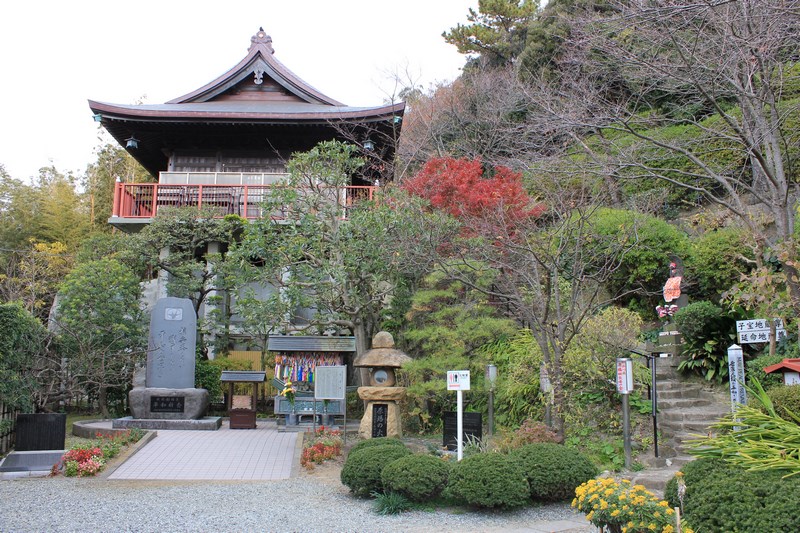We continue our journey through the southern part of Kanto and move to the Ofuna railway station, on the way to which from the train window you can see the magnificent outlines of another unusual Buddhist temple, Ofuna Kannon (Ōfuna Kannon). As you may have guessed from the name, this temple is also dedicated to the goddess of mercy Kannon. The temple complex is within walking distance from the railway station and is located on a mountain. Entry fee is 300 yen.
The temple itself is a huge 25-meter white statue of the goddess, inside of which there is a small museum open for viewing at any time. You can get to the statue by a long staircase, consisting of many steps. At the top of the stairs, you will have an extraordinary view of the statue, smiling back in a friendly way. Inside the statue there are many figurines of small gods and a rather large statue of the goddess herself. The museum tells the complex story of the creation of the complex and the statue itself, made by hand. The temple is surrounded by bamboo thickets and other vegetation, which creates a feeling of solitude and cut off from the whole world.

Ofuna Kannon Temple differs from other Buddhist temples not only in that it is located inside a huge statue, but also in unusual buildings and monuments that are part of the complex. One of these is the cenotaph erected in memory of the victims who died during the bombing of Hiroshima and Nagasaki. The memorial includes an eternal flame; stones brought from the epicenters of attacks on cities; thousands of multi-colored cranes brought by parishioners, etc. It is worth saying that the atmosphere on the territory of the temple complex is saturated with hope and a thirst for peace and tranquility. It is very quiet here, candles are burning everywhere, and it smells of incense. The mountain offers a stunning view of the city, which once again makes you feel like such a small person.
Let’s move a little west to Shizuoka Prefecture.
I was lucky to get to this absolutely amazing place at the beginning of February 2014. My college friend is from Shizuoka and one day she invited me to her house for a few days. There are many ways to get to Shizuoka from Tokyo: by high-speed shinkansen, regular train, bus or car, and the total travel time does not exceed two hours.
In my opinion, Shizuoka deserves a separate article, because there is so much to tell about this prefecture! But since we touched on the topic of Japanese temples, the last one for today will be the Shinto shrine of Shizuoka Sengen (Shizuoka Sengen Shrine). The structure of this temple complex includes three Shinto shrines – Kambe (Kambe Jinja), Sengen (Sengen Jinja) and Otoshimioya (Ōtoshimioya Shrine) – located on one vast territory near Mount Shizuhata. On the territory of the temple there is a large pond, a traditional Japanese garden with red bridges and about 10 separate small temples, each of which is dedicated to its own god.

Since we were in Shizuoka in early February, my friend’s family, having learned about my interest in Japanese temples, decided to invite me to the congregational prayer, which takes place only a few times a year (early February, April, late June, or daily in December). During such a prayer, people come to ask for different things, for example, for the protection of their home, well-being in childbirth or travel, the blessing of a newborn baby (like Orthodox baptism), protection from ailments, etc. Depending on the purpose of the prayer, parishioners visit different churches and different ceremonies.
Surprisingly, on this day there were quite a lot of people in the temple, photo shoots were held and it was slightly busy. It is worth saying that the Japanese seemed to me quite far from religion or faith, and I got the impression that their trips to the temple are still a tribute to traditions, rather than a call of the heart. But like in any other country, different people with different views live in Japan, and most often the inhabitants of the province (and Shizuoka is considered a province) are significantly different from representatives of more advanced cities or the capital.
My friend and I got to a prayer dedicated to health.
The most interesting moment in this prayer is the ritual dance of the servants of the miko temple – kagura. Kagura is a dance pantomime accompanied by flute and drumming. Two miko, dressed in festive clothes, move their hands so unusually, bewitching the parishioners with their movements, that you forget about everything in the world. At the end of each prayer, parishioners who have ordered and paid for the ceremonies in advance receive personalized temple talismans that can be placed at home on a special kamidan altar. It is worth noting that the Japanese are quite calm and understanding about the participation of foreigners in prayer, and they help in every possible way if you do not understand anything at all and do not know what to do.
